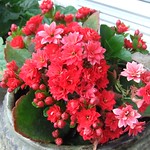Tips on Growing and Caring for Kalanchoes

 Kalanchoes are popular houseplants which are often sold as gifts – complete with brightly colored wrapping covering the pot. Their vivid flowers are just the thing to perk up the windowsill in the dark of winter. These plants are more than a temporary fix of color. With a little care kalanchoes can live to bloom again for many years.
Kalanchoes are popular houseplants which are often sold as gifts – complete with brightly colored wrapping covering the pot. Their vivid flowers are just the thing to perk up the windowsill in the dark of winter. These plants are more than a temporary fix of color. With a little care kalanchoes can live to bloom again for many years.There are over 130 species of kalanchoe, a member of the Crassulacae family. The klanachoe commonly sold as a houseplant is Kalanchoe blossfeldiana. Its flowers have four petals while other Crassulacae have five. Its scalloped leaves are a deep glossy green and its flowers come in shades of red, orange, yellow, pink and white.
Like other succulents, kalanchoes do not like to sit in water. If you receive a plant with a plastic wrapping around the pot, remove it to allow water to drain through the pot. Sometimes kalanchoes are sold in plastic pots which are placed in a decorative ceramic pot without a drain hole. If you want to keep using the ceramic pot, remove your kalanchoe to water it, and don’t replace it in the closed pot until water has finished draining from it. Do not water your plant again until the soil is dry.
When the flowers eventually turn brown you should snip them off to prolong the blooming season of your plant. Long stems can be pruned back and cuttings can be taken to start new plants. Kalanchoes root easily from stems inserted in potting soil.
After the flower has finished blooming, you can repot your plant in a slightly larger container. You should use a quick draining soil such as cactus mix with additional pumice or perlite added. A balanced fertilizer – one with three numbers that are the same – will help your plant thrive. Fertilizer can be applied monthly from May through October. Overfertilization will result in lots of leaves and few flowers.
Since kalanchoes are photo periodic you can encourage the plant to bloom again by cutting back on the amount of light it receives. They need 12 hours of darkness to set blooms. Once the blossoms have formed, the amount of light is not critical.
Although they can live as house plants, kalanchoes will grow happily outdoors. If you live in a frost-free area they can be planted in the ground. Their leaves can become damaged by intense sunlight. Morning sun or dappled shade is better.
A new variety of kalanchoe - the calandiva - has arrived on the scene. It comes in many of the same bright colors ad the kalanchoe but its flowers resemble miniature roses. The calandiva pictured above has been blooming all summer on a shady patio.
This site needs an editor - click to learn more!

Related Articles
Editor's Picks Articles
Top Ten Articles
Previous Features
Site Map
Content copyright © 2023 by Linda Genis. All rights reserved.
This content was written by Linda Genis. If you wish to use this content in any manner, you need written permission. Contact
BellaOnline Administration
for details.


